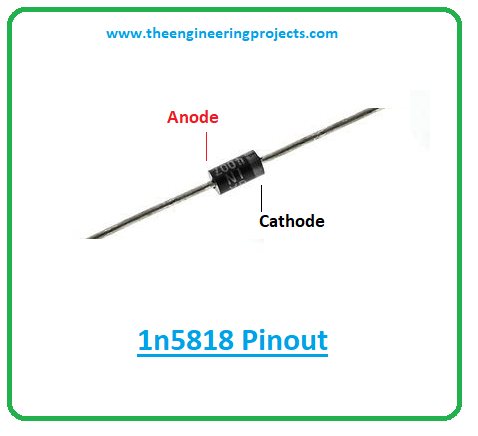 Hi Guys! Hope you’re doing well today. I welcome you on board. In this post today, I’ll walk you through the Introduction to 1n5818.
Hi Guys! Hope you’re doing well today. I welcome you on board. In this post today, I’ll walk you through the Introduction to 1n5818.
The 1n5818 is a Schottky diode. It is also known as a hot-carrier diode that is employed for extremely fast switching applications. It carries high forward surge capability and low forward drop voltage, making it a suitable pick for high-frequency applications. It is available in the DO-201AD package and comes with very small conduction losses.
I recommend you buckle up as I’ll discuss the complete introduction to 1n5818 covering the datasheet, pinout, features, and applications.
Without further ado, let’s get started.
Introduction to 1N5818
- The 1n5818 is a Schottky diode that is incorporated in extremely fast switching applications. It is also known as a hot-carrier diode.
- It is available in the DO-201AD package and comes with low forward drop voltage and high forward surge capability.
- MOSFETs semiconductors are the appropriate alternatives to these Schottky diodes and where less power dissipation is needed, MOSFETs replace these Schottky diodes.
- Low electronic energy in an unbiased condition is responsible for the formation of a barrier on these Schottky diodes that restricts the movement of electrons. This barrier formation is the main reason these diodes devise are also named hot-carrier diode.
- Know that… generally, both Schottky diode and regular diode are the same devices in terms of the current flow i.e. both devices support the conduction process in one direction only and restrict it in the opposite direction. And current flows from the anode pin to the cathode pin.
- These devices, however, stand different in terms of the voltage required to power up these devices. Both components receive 2V DC source voltage out of which Schottky diode requires only 0.3V leaving behind 1.7V to power up the diode devices. And regular diode requires only 0.7V, leaving behind only 1.3 potential difference to power up the component.
1N5818 Datasheet
Before applying this component into your circuits, it’s wise to read the datasheet that details the main characteristics of the device. Click the link below and download the datasheet of 1n5818.
1N5818 Pinout
- The following figure shows the pinout diagram of the 1n5818 device.
- This power diode carries two terminals called as anode and cathode. The external circuits are connected with the diodes through these terminals.
- And current flows from the anode terminal to the cathode terminal.
- The anode terminal is positive while the cathode terminal is negative.
- The current enters the diodes from the anode pin while it leaves the diode from the cathode pin. Again, current flows in one direction only.
- You cannot force this device to flow current in the opposite direction. Doing so will damage the device and thus the entire project.
1n5818 Schottky Diode Construction
- The 1n5818 is made by the mixture of metal with the semiconductor material that results in the creation of a barrier.
- When the metals like platinum, tungsten, chromium, and molybdenum are joined with the n-type semiconductor material, they create a Schottky diode. The n-type semiconductor is the semiconductor material where electrons work as major carriers and holes work as minority carriers.
- The Schottky diode comes with two terminals called anode and cathode. The anode side is positive and the cathode pin is negative. The anode pin is made of metal material and the cathode pin is made of semiconductor material. Know that… the current enters the diode from the anode side and it exits the diode from the cathode pin. The current moves from the positive anode side made of metal to the negative cathode side made of semiconductor material.
- The forward drop voltage of the Schottky diode is mainly dependent on the nature of metal and semiconductor material that is used to create the barrier that blocks the movement of electrons.
- Both n-type and p-type semiconductor material can be employed to operate as a cathode terminal in Schottky diode, but n-type materials are preferred over p-type material because the latter carries with low drop voltage.
1N5818 Features
- Guarding for overvoltage protection
- Very small conduction losses
- Carries high surge capability.
- Contains low forward drop voltage.
- Extremely fast switching
- Available in package DO-201AD.
- Low forward voltage drop
- High-frequency operation
- Protected against overvoltage.
1N5818 Applications
- Employed in radio frequency applications.
- Applied in solar systems.
- Incorporated to control the electronic charge.
- Used in high-frequency and low voltage inverters.
- Used in sample-and-hold circuits.
- Used for signal detection and extremely fast switching applications.
- Used in polarity protection and DC/DC converters applications.
- Used in freewheeling and logic circuits.
That was all about the Introduction to 1n5818. If you’re unsure or have any questions, you can pop your question in the section below, I’d love to help you according to the best of my expertise. You’re most welcome to share your valuable suggestions and feedback around the content we share and keep helping us produce quality content customized to your exact needs and requirements. Thank you for reading the article.
JLCPCB – Prototype 10 PCBs for $2 (For Any Color)
China’s Largest PCB Prototype Enterprise, 600,000+ Customers & 10,000+ Online Orders Daily
How to Get PCB Cash Coupon from JLCPCB: https://bit.ly/2GMCH9w
The post 1N5818 Schottky Diode Datasheet, Pinout, Features & Applications appeared first on The Engineering Projects.

No comments:
Post a Comment